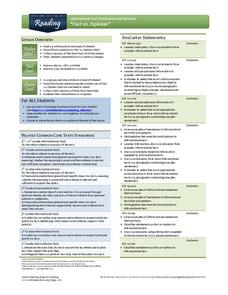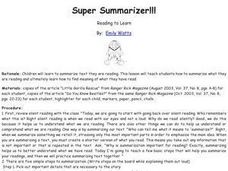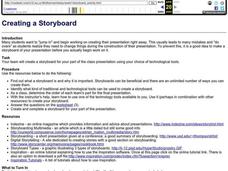Curated OER
Writing An Article
Young writers compose an article on the benefits of healthy eating. They are coached on how to use the passive voice in their writing. On the whiteboard, they brainstorm ideas of why healthy eating is important, then use those ideas to...
For the Teachers
Fact vs. Opinion
Many informational texts are written as factual, but can your learners determine when an opinion is presented as fact? Have your kids read several articles on the same topic and record the statements that contain either facts or...
Curated OER
Summarize This!
Students explore how to summarize a reading passage. They read non-fiction books. Students use a Venn Diagram to compare and contrast the two animals they read about. They write a summary using the information in their Venn Diagram.
Curated OER
Super Summarizers
Students examine the process of summarization by creating an event map. They discuss the process of summarizing text, then silently read an article from "Time For Kids" magazine. Students observe the teacher create a map for the...
Curated OER
Synonymous Sharks
Students locate and read an Internet article on sharks. They write a summary of the article, and complete a Concept of Definition Map using information from the article.
Curated OER
Super Summarizer!!!
Emerging readers summarize a nonfiction text using a five step process. After a brief demonstration of the five-step method for summarizing text, they read a nonfiction article and write their own summary. A checklist of each summary is...
Curated OER
Summing It Up Can Be Fun!!
Learners observe and demonstrate the process of summarizing text. As a class, they silently read an article about panda bears from "Ranger Rick" magazine and answer comprehension questions. They answer the five "W" questions, and write...
Curated OER
Some Simple Rules to Sum it Up!
Students observe and demonstrate three steps to summarize text. They read and discuss the three steps to summarizing, then silently read an article about dugongs from "National Geographic Kids" magazine. Students demonstrate the three...
Curated OER
Reading And Summarizing in Science
Students read articles about various scientific topics from a variety of science disciplines and a variety of sources including newspapers, the internet, scientific journals and magazines for students. They review the articles...
Curated OER
Can you Summarize?
Students write summaries of non-fiction articles in this lesson. They read the article silently and then pick out the main points. Students list the main events as a whole class activity, and then they individually write a summary of...
Curated OER
Get the Skinny! Summarize a Story!
Students examine the steps of summarizing text. They silently read an article, then read and discuss the steps to summarizing a passage. Students then write a summary of the article they read, and as a class discuss the main idea,...
Curated OER
Ten Cents a Word
Students recognize the importance of summarizing in this lesson. They "sum up" an article about monarch butterflies. Students practice writing summaries of the article charging themselves 10 cents/word. They try to write the least...
Curated OER
A Splendid Summarization
Students review three steps to follow to correctly summarize a written passage. Through modeling, guided and independent practice, they distinguish between unimportant and important information and summarize an article using these steps.
Curated OER
Summing it all Up...In Your Own Words
Young scholars observe and demonstrate the steps to identifying the main ideas of a text. They listen to the teacher read a paragraph and model the steps of summarizing the main idea. Students then independently read a different...
Curated OER
Mapping Out Summarization
Students summarize a selected piece of text using a a six step process. After reviewing the correct way to read silently, students read a selected piece of nonfiction text. They write a summary paragraph using the six step process...
Curated OER
Reading to Learn What's The Point
Students explore the benefits of summarizing in this lesson. The students define summarization and review the six step process. They listen as the teachers reads "Land of the Rings" and then write an individual summary using the six...
Curated OER
It's Time to Sum It Up!!!
Students practice the reading strategy of summarization skills by picking out main events or ideas while reading a chapter in a book. They interact with the article, "SuperCroc," from National Geographic for Kids magazine to summarize...
Curated OER
Summing It All Up
Students read articles and summarize the main points in this instructional activity. Students read a provided article from National Geographic Kids and create a web detailing the main points. They then use a six step process to write a...
Curated OER
To Tell You in a Nutshell
Young scholars discuss the importance of comprehension and the use of summarization. Through guided practice, they follow six steps in finding and highlighting important information from an article, while deleting information that is not...
Curated OER
African American Experiences: Window to the Past
Students examine African life during slavery on the Internet. In this slavery lesson, students use the Internet to research slavery and create a scrapbook. Students review pictures of slavery and label them as primary or secondary sources.
Curated OER
Creating a Storyboard
Students find out what a storyboard is and why it is important. They identify what kind of traditional and technological tools can be used to create a storyboard and determine the order of each team's part for the final presentation.






















